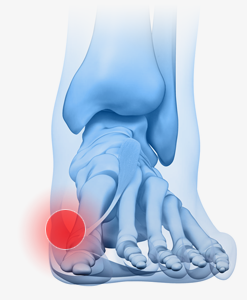Bunion Surgery in Brooklyn

SOME FACTS YOU SHOULD KNOW ABOUT BUNIONS
A large percentage of the population is likely to develop a bunion. Both men and women can develop bunions, although it appears that bunions are more commonly seen on women`s feet. A bunion is a swelling or enlargement of the large toe joint on the inner side of the foot. The deformity usually develops gradually and will cause foot discomfort and pain from shoes rubbing against the enlarged bone without bunion orthotics. There may be swelling, redness and deep aching pain associated with the bunion joint, causing a bursitis.
WHY DO BUNIONS DEVELOP?
Bunions develop from a weakness in the bone structure of your foot. There is a strong possibility that heredity is the underlying cause. As a result, the joints have a tendency to move out of proper alignment given the instability of the bones and ligaments that form the various joints and arches in your feet. The bunions are not caused by improper shoegear but are significantly aggravated by improperly fitting shoes that place an unusual degree of pressure at the bunion joint.
As bunions become more severe, the joint moves out of proper alignment and eventually arthritis damages the joint space causing foot discomfort. The large toe will move sideways towards the second toe, and the foot tends to widen across the metatarsal area. This is a mechanical consequence not usually caused by shoegear. However, shoegear can certainly aggravate the condition and speed up the development of a more serious and significant deformity.
If bunion surgery is recommended, our bunion specialist will discuss the surgical bunion procedures that are best suited for your particular bunion deformity. There are many different types of bunion procedures now available, many having been developed by podiatrists specializing in this type of surgery. The procedure selected is based on examination, X-ray findings, age and activity level of the patient; factors that can influence the final outcome. In all cases, both bunion surgeon and patient need to work as a team for a successful and satisfactory result.
WHAT KIND OF BUNION SURGERY IS REQUIRED TO REPAIR MY BUNION?
Mild bunion deformities that require bunion surgery usually are treated by removing a small portion of the enlarged bone at the head of the metatarsal. Our bunion surgeon may also lengthen the tendons around the joint to realign the big toe. In more severe bunion deformities, your podiatrist may choose to perform several different bunion procedures to realign the metatarsal. In some cases, pins, stainless steel screws, staples, wires or artificial joint implants are used so that realignment of the joint is maintained while the bone is healing. To learn more about bunion surgery and bunion pain relief in Brooklyn, NY, contact us today!
TAILOR`S BUNION DEFORMITY
A tailor`s bunion is a small bunion at the base of the little toe. This condition is also known as a Bunionette. The name Tailor`s Bunion was derived from the way tailors used to sit with their legs crossed as they worked. Crossing their legs put pressure on the area known as the fifth metatarsal head, subsequently resulting in pain.
There are a few conditions which may cause the "bump" in this area:
1. An overgrowth or swelling of the soft tissue covering this joint (bursitis).
2. A congenitally (at birth) wide head of the fifth metatarsal bone.
3. An actual bowing and/or splaying of the fifth metatarsal bone.
HOW ARE TAILOR`S BUNIONS TREATED?
Where the bone is splayed, the bunion surgery will consist of cutting through the bone or cutting out a wedge of bone to improve its position to provide bunion pain relief. These procedures are known as osteotomies, corrective surgical fractures of the bone.
SUMMARY
Remarkable advances have been achieved for foot care in the past several decades with instrumentation and technology to improve medical and surgical procedures that a podiatrist including bunion orthotics.
Many of the surgical procedures described in this brochure can be performed in an out-patient setting. Remember both you and your bunion specialist are a team working toward a common goal - comfortable feet - so that you can remain active in today`s fast-paced world. Do not hesitate to ask our orthopedic surgeons any questions you may have concerning bunion treatment and surgeries recommended to you. Our orthopedic surgeons are located in Brooklyn, Queens, and Manhattan NY.
